Bone In Ribeye Steak (Reverse Sear Method)
When you savor your juicy, tender bone-in ribeye steak made with the reverse sear method, you may just get hooked. The simple two-step process delivers fabulous results.
If you’re looking for a perfectly cooked juicy steak on the inside and beautifully crusted on the outside, you are in the right place.
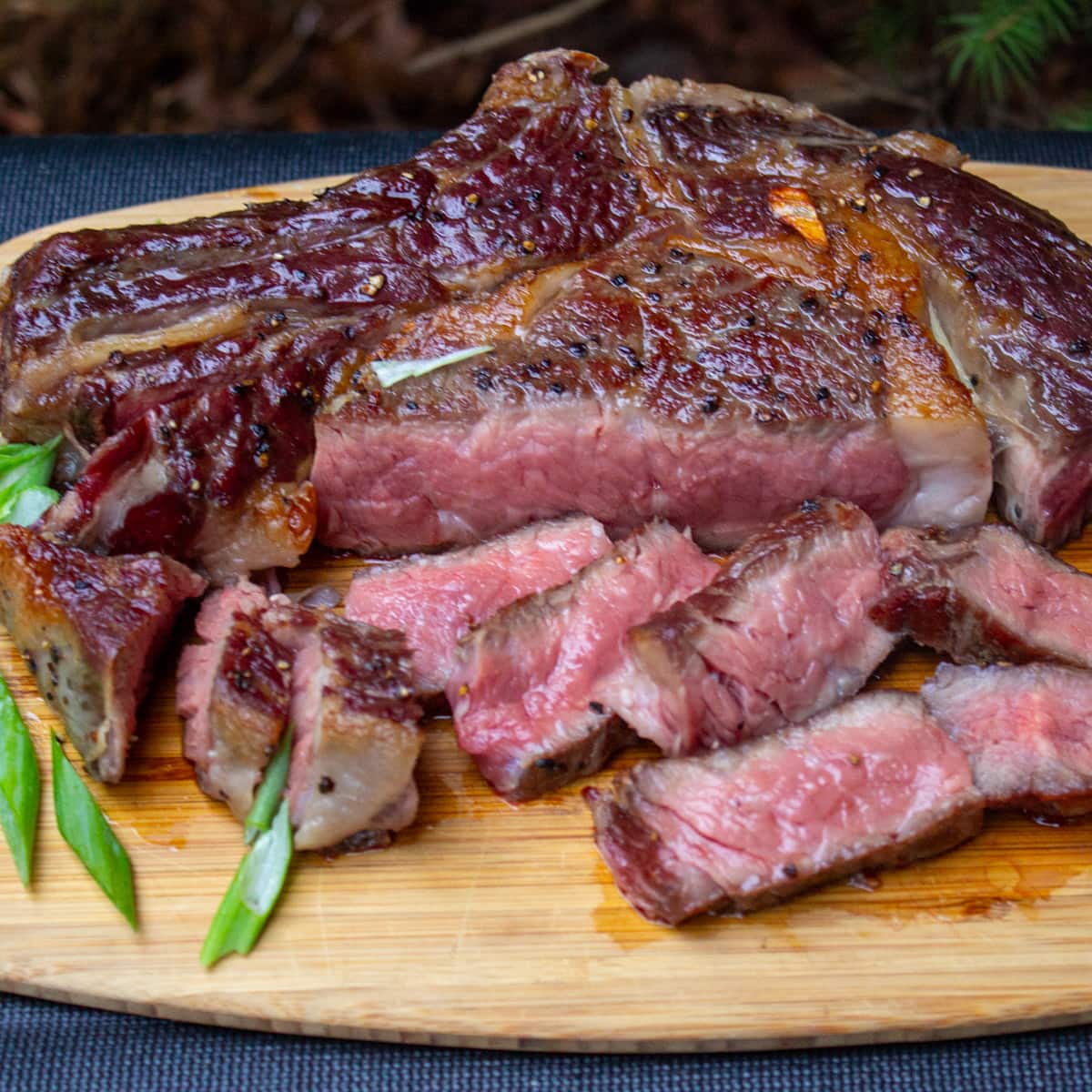
With steak prices so high these days, you want the best way to get it right. This method is well worth a try.
We will take it step by step (with tips) to a mouthwatering meal with some great serving suggestions.
What to expect
Reverse searing a steak is a two-step cooking method: First, you slowly cook the steak in the oven at a low temperature, then do a final quick pan-sear at a high temperature to form a perfect crust.
The reverse sear method has three advantages:
- The meat is cooked evenly edge to edge – to the level of doneness you like – with a beautifully caramelized crust. No gray edge on the outside with pink only at the center.
- You can pause between the two steps, allowing time for other dinner prep. I like to do the final 2-minute step just before serving to get hot meat to the table.
- Excellent results: The initial slow cooking helps prevent dry overcooked meat, while the final sear adds a beautiful browned finish (called the Maillard reaction). The bottom line is a tender juicy steak with better control over the cooking process and no fancy equipment.
The downside of this method is that it takes longer than a traditional quick grill or pan-sear. And, it only works if your meat is on the thicker side. One steak will feed at least two people.
Regarding equipment, you will need a wire rack to sit over a pan, a grill or cast iron pan (or similar) and a meat thermometer.
Ingredients – tailored to your taste
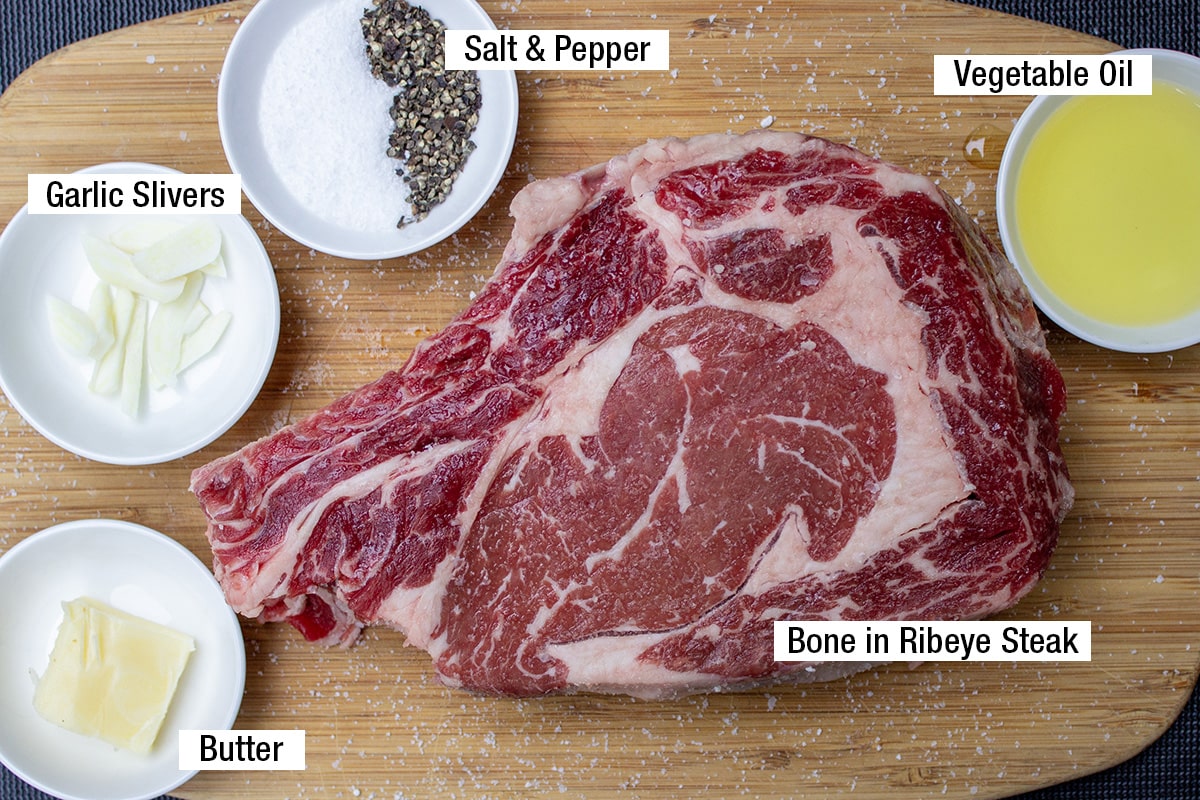
Steak: You will need a thick steak for this recipe – at least 1.5 to 2 inches thick (3.8-5 cm). You may need to ask a butcher for thicker steaks. Buy a well-marbled bone in ribeye steak or another high-end cut if you prefer. See FAQs for best cuts. Ribeye is one of the most tender, flavorful cuts of beef you can buy.
Seasoning: Purists like to keep it simple with just kosher salt and freshly ground pepper. I like to add garlic slivers (slipped between the fat and meat). Alternatively, add the garlic along with butter and fresh herbs in the final searing step.
Variations:
- Type of meat: The reverse sear method works well with any tender thicker cuts of steak such as New York strip, filet mignon, porterhouse steak, Tomahawk steak, or boneless ribeye. It is also a great method for pork roast, prime rib, and pork chops.
- Seasoning: feel free to use your favorite steak seasoning. Two good ones are Montreal Steak Seasoning and Santa Maria Seasoning.
- Final cooking step: Instead of pan searing, the last step can be done on a hot grill, heated to a screaming hot temperature.
Step-by-step instructions
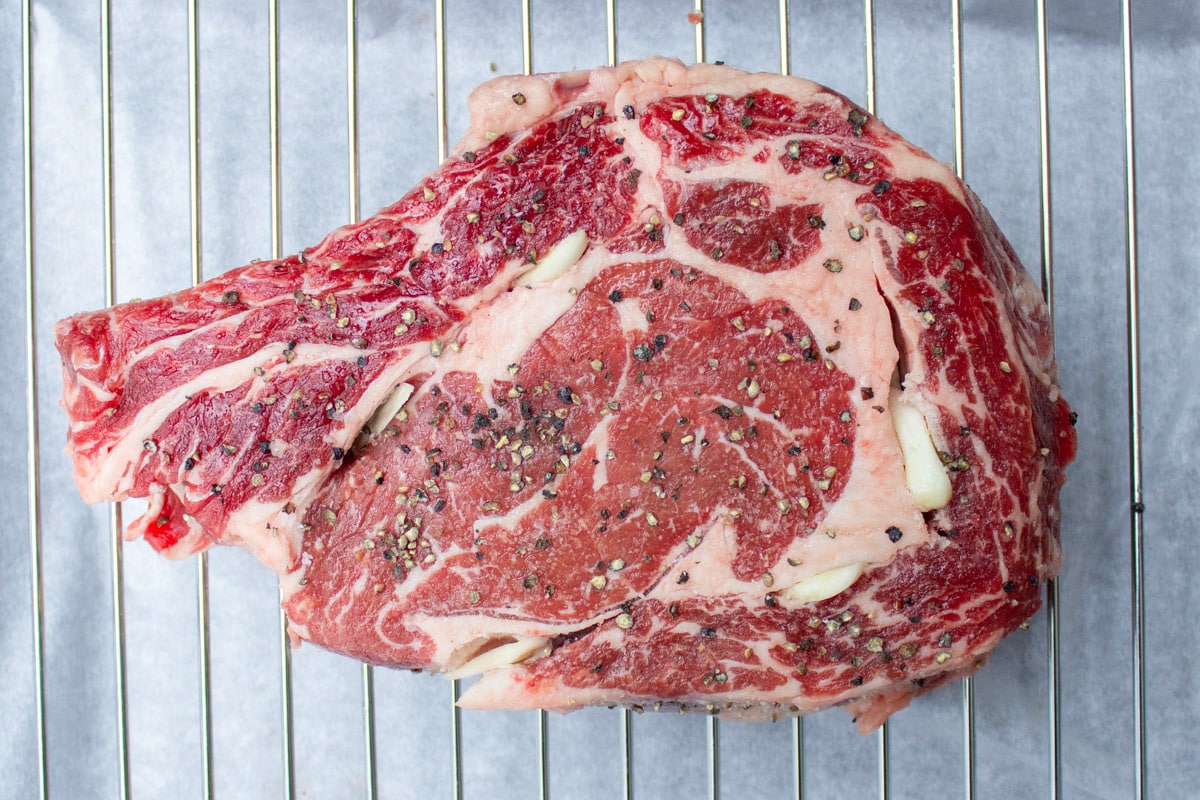
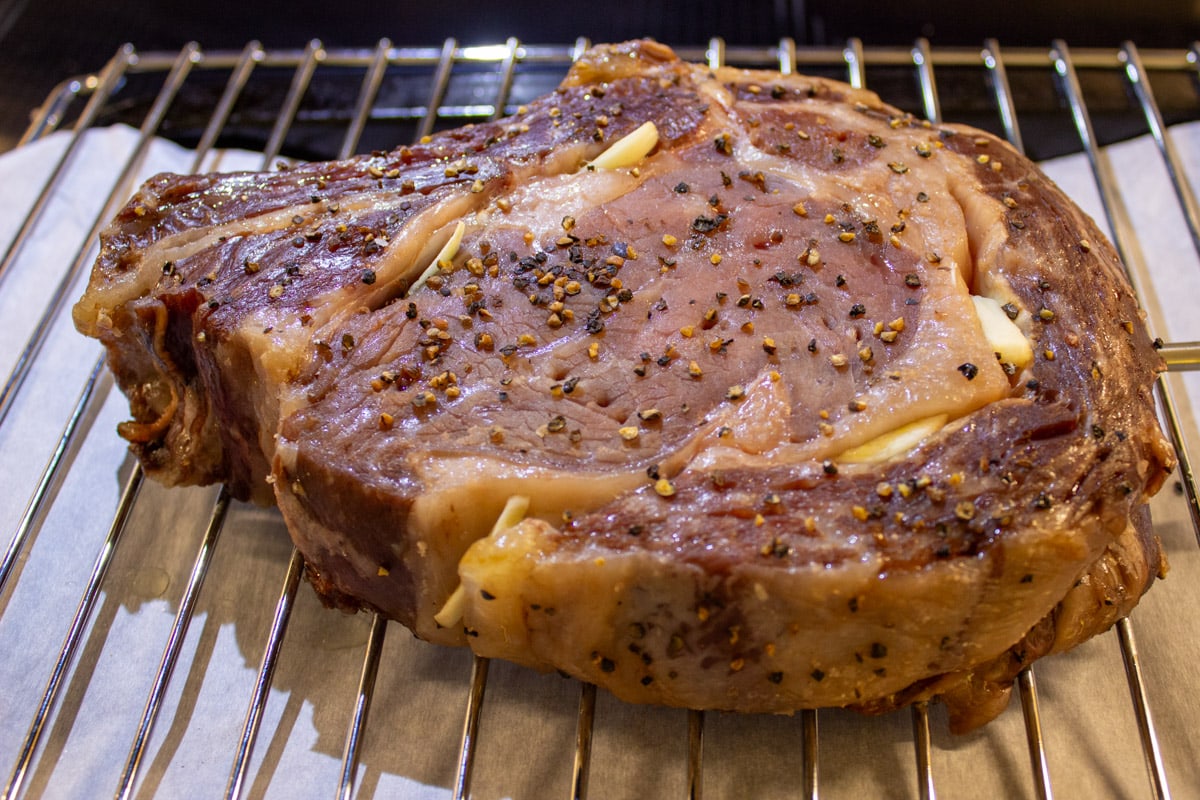
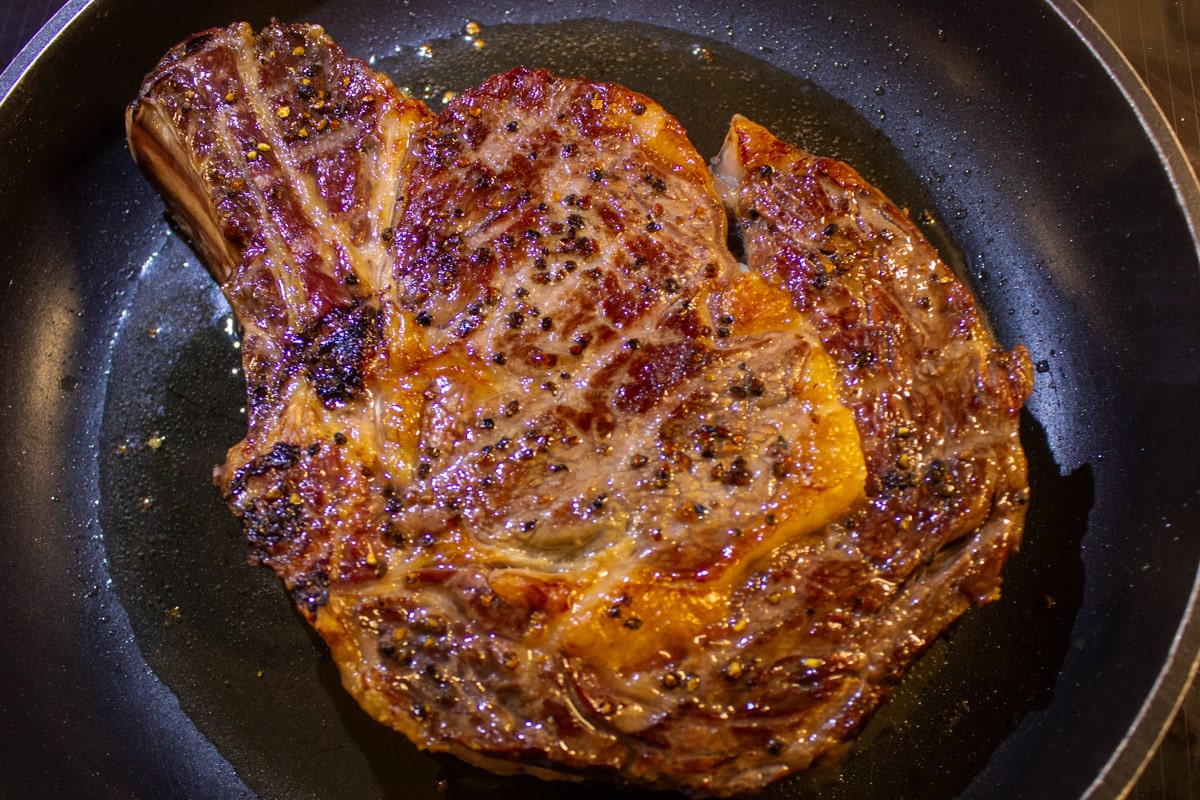
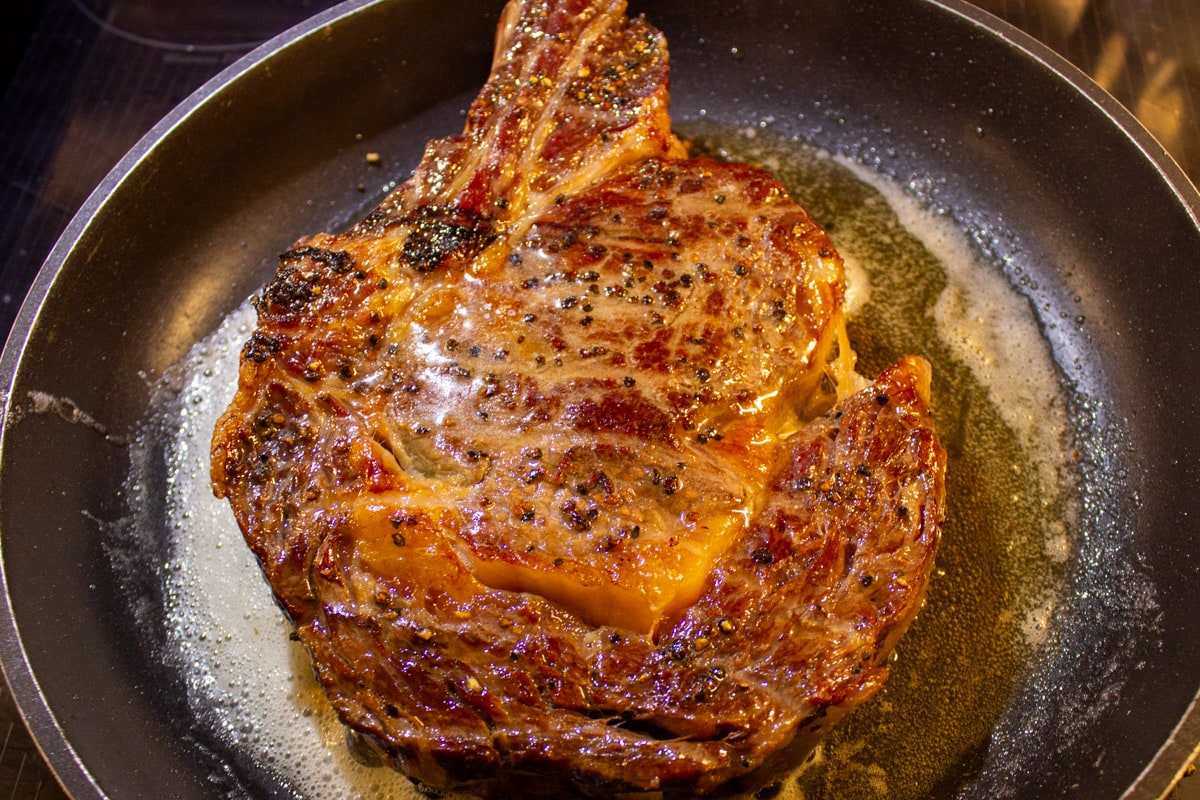
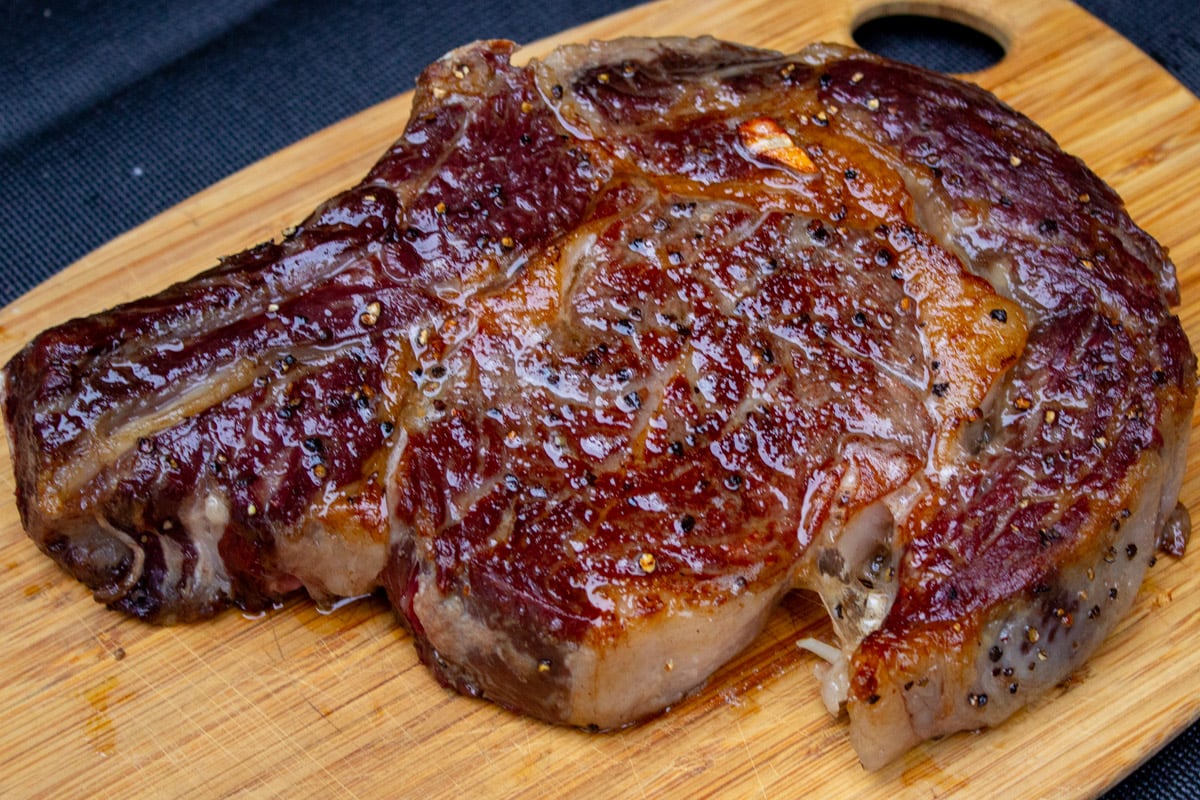
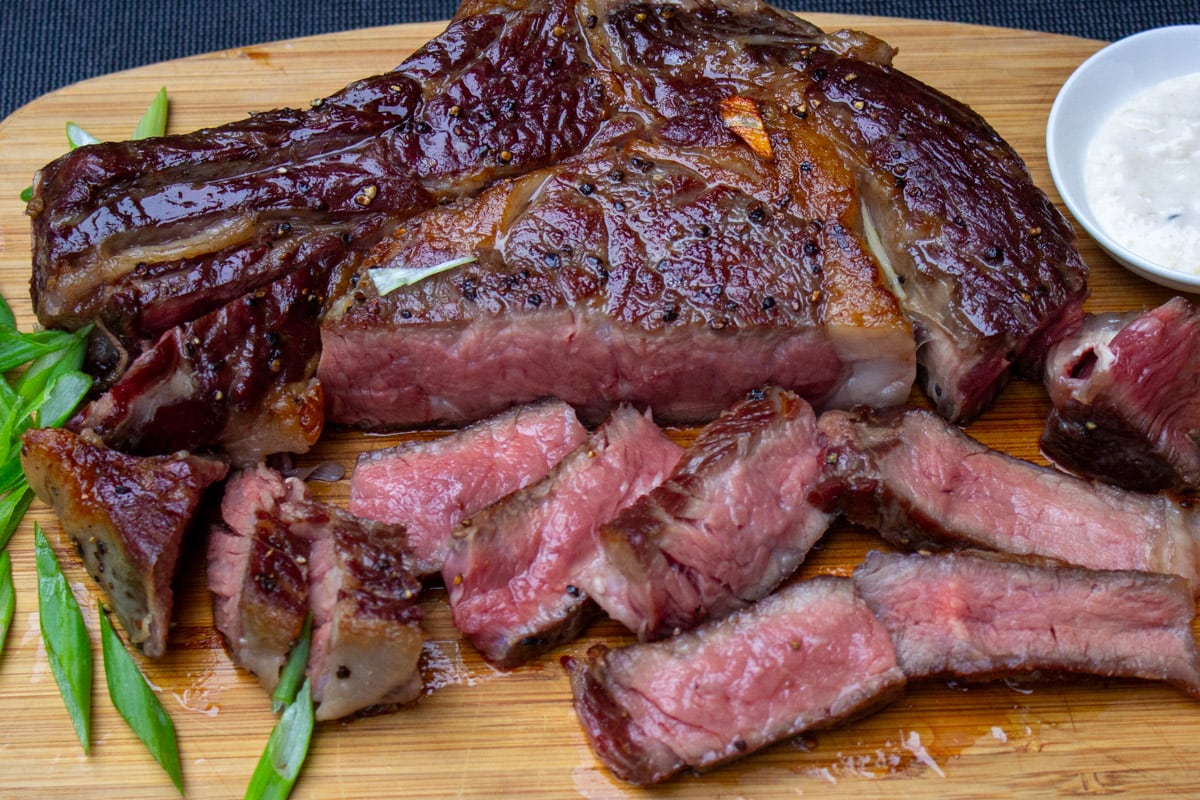
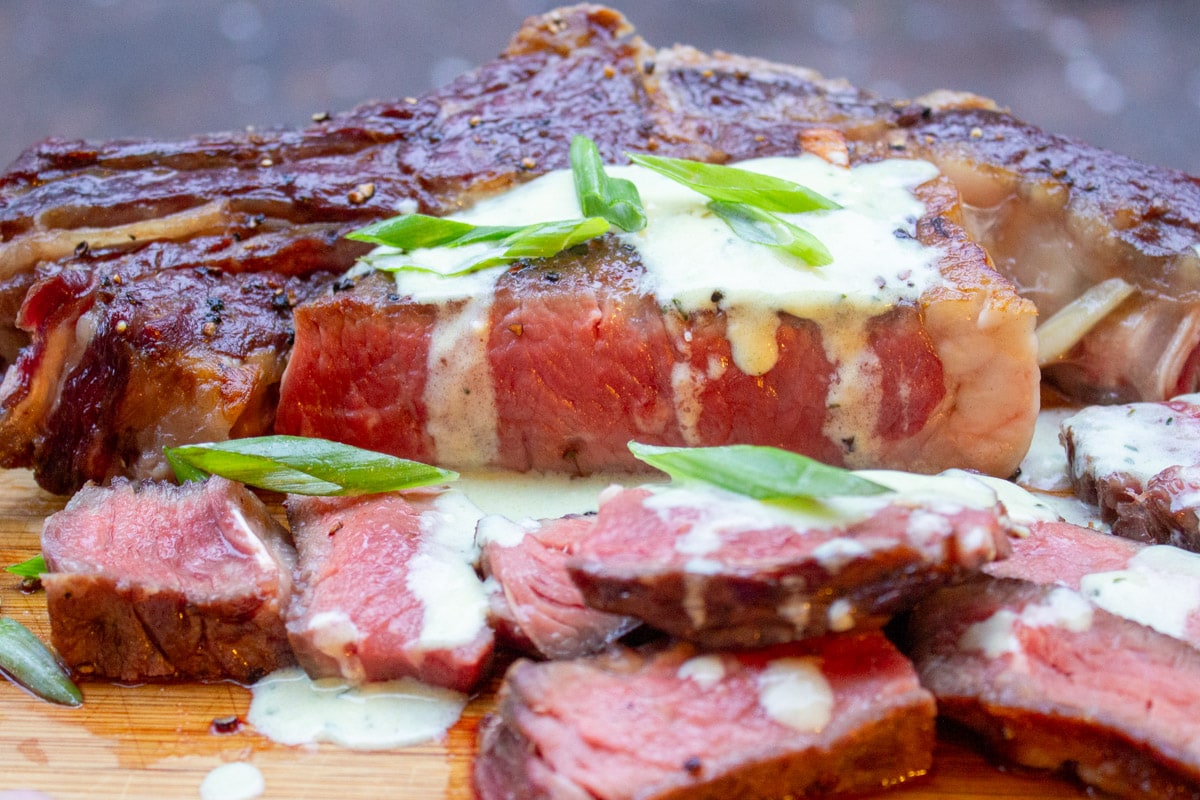
What to serve with reverse sear ribeye steak
Condiments: You can stick to the classic butter-herb-garlic topping or try one of these other condiments.
- chimichurri
- herb sauce (5 minutes)
- sriracha aioli (2 minutes)
- horseradish sauce
- bearnaise sauce (I use Knorr – shh!)
Side dishes and salads: Here are some favorites – crispy oven roasted potatoes, creamed spinach, balsamic glazed carrots, lemon orzo salad with grilled vegetables, charred corn salad with lime and cilantro and quinoa avocado salad with roasted carrots and beets.
Tips for perfect reverse-seared steak
- Thick-cut steak: The reverse sear method works best with steaks that are at least 1 1/2 to 2 inches thick (3.8-5 cm)
- Dry brining the steak with salt is optional but adds flavor, juiciness and tenderness. Instructions are in the recipe notes. Highly recommended.
- Bring the steak to room temperature before cooking. This ensures even cooking.
- Use an instant meat thermometer or probe to measure the temperature. This is very important to help achieve your desired doneness.
- Level of doneness: Choose your preferred doneness (medium rare, rare, etc) with the time and temperature chart in the recipe card.
- Butter basting with herbs and garlic is optional but adds wonderful color and flavor. Check out the other condiment options though.
- There is no need to rest the steak after the initial low-temperature cooking stage or before the final high-heat pan-searing, but you can pause between these steps if you need the extra time.
Shortcut
Skip the optional dry brining step if you don’t have time. You can also cook a thicker steak at a slightly higher temperature (e.g. 275F/135C) which will take less time.
Make Ahead
The steak is best served fresh off a hot pan, but with the two-step reverse sear process, you can pause for 30 minutes and do the final searing step before serving. You can also freeze cooked ribeye, keeping in mind you will lose some taste and texture when reheated.
Recipe FAQs
Reverse searing is a cooking method that involves cooking meat slowly at a low temperature in an oven or smoker and then finishing it with a high-temperature sear in a skillet. It is the opposite of the traditional method – and results in a tender and juicy interior with a flavorful outer crust. Here is the science behind reverse searing if you’re interested.
Look for USDA Prime or Certified Angus Beef (high quality grades and most expensive). ‘USDA Choice’ grade is the next highest quality (similar to AAA in the Canadian grade system). It’s a bit less marbled but still good. ‘Select’ will be cheaper, less juicy and less tender
Ribeye steak is a well-marbled (fatty) cut of beef making it extremely tender and flavorful even with cooked at high heat. It is essentially a prime rib roast cut into steaks and can be with bone or without.
Both the sous vide and reverse sear methods are known for producing tender and juicy meats. By cooking the meat at lower temperatures for longer durations, they help break down the connective tissues and achieve a more tender texture. Both the reverse sear and sous vide steak will require a final searing step to create a caramelized crust on the meat. Sous vide allows for a precise temperature, so there is no need to check it to get it right – a big advantage.
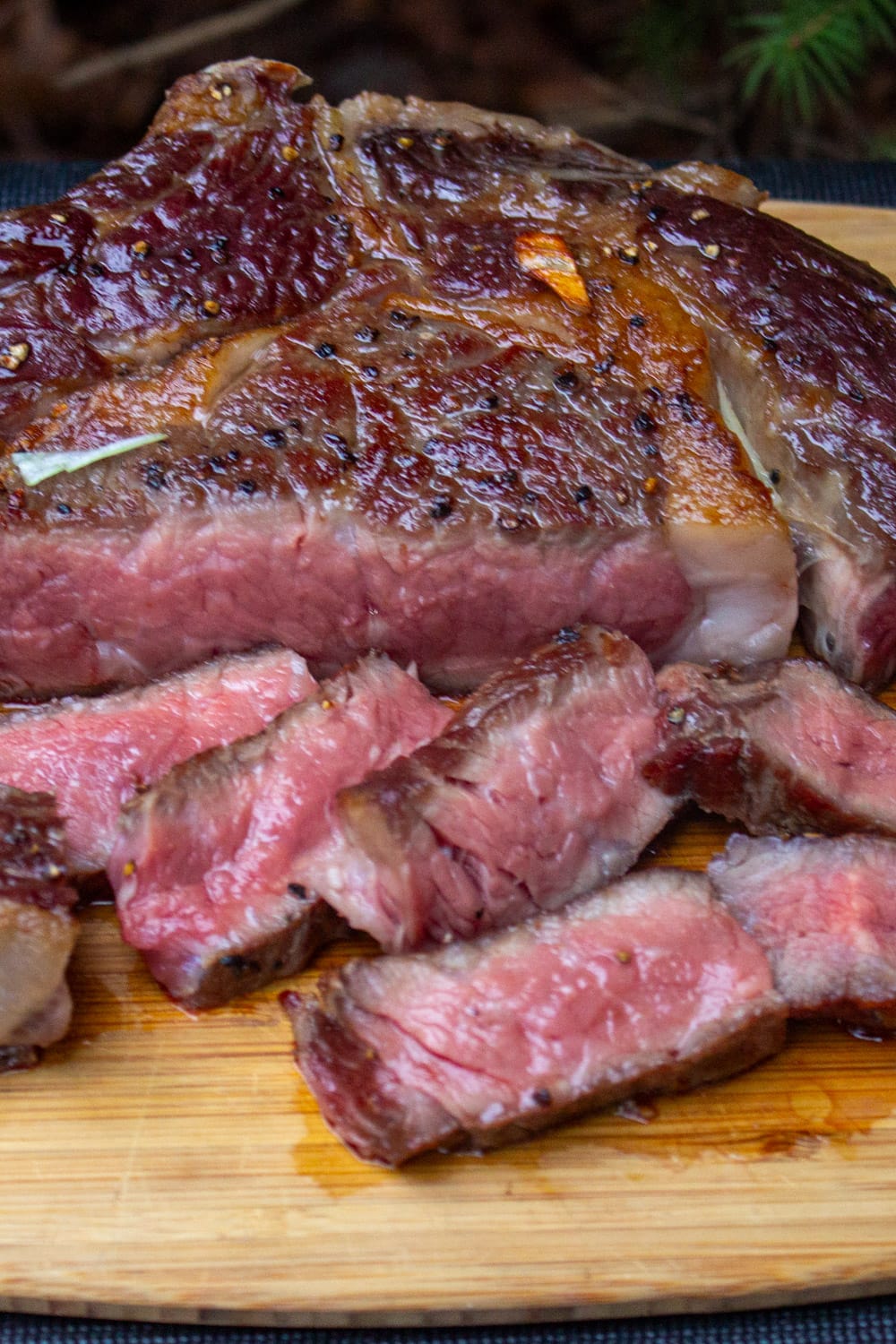
More reverse sear recipes
Bone In Ribeye Steak Recipe (Reverse Sear Method)
Equipment
- instant read meat thermometer (or probe)
Ingredients
- 2 pounds bone-in ribeye steak, at room temperature, Note 1 1 steak 1.5-2 inches thick (3.8-5 cm)
- kosher salt and black pepper
- 2 cloves garlic, cut in slivers (optional)
- 1 tablespoon oil with low smoke point for searing avocado oil, vegetable or canola oil (not olive oil)
Butter-herb-garlic baste (optional)
- 1 tablespoon butter
- 2 garlic cloves cut into chunks or lightly smashed
- fresh rosemary and/or thyme sprigs (pinch of dried will work too)
Instructions
- Timing will depend on thickness of steak. It also assumes steak is at room temperature (45-60 minutes) and brining is complete if using (2- 24 hours).
- DRY BRINE STEAK (OPTIONAL): Note 2.
- HEAT OVEN TO 250F/121C. Note 3. Line a rimmed baking sheet with parchment paper or aluminum foil and place a wire rack on top.
- SEASON STEAK: Generously season steak with kosher salt and pepper. If you like, slip a few slivers of garlic between the fat and muscle in several places (optional).
- SLOW COOK IN OVEN (stage 1): If you have a temperature probe, insert it from the side of the steak to the middle, not touching any bone. Place steak on prepared pan and put it in oven to cook. Check it with a meat thermometer after 20 minutes. Keep checking every 5-8 minutes until you reach your desired temperature for the first stage (it will finish cooking in stage 2). Remove from oven at: (final temperature after stage 2 is shown in brackets)° 105F/41C – for rare, ~20-25 minutes (final temp: 120F/49C)° 115F/46C – for medium rare, ~25-30 minutes (final temp: 130F/54C)° 125F/51C – for medium, ~30-35 minutes (final temp: 140F/60C)° 135F/57C – for medium well, ~35-40 minutes (final temp: 150F/65C)** times are approximate and depend on thickness of steak – best to use a thermometer!
- PAN SEAR (stage 2): Heat oil in a cast iron skillet (or any skillet that can handle high heat) to VERY HOT – shimmering, almost smoking. Pan sear steak for 45-90 seconds per side (and edge) until a deep brown crust forms. Don't sear it too long or the steak will overcook. Note 4.Optional: If you want to get a more flavorful crust with a butter-herb baste, turn down the heat on the skillet to medium, add the butter, crushed garlic and fresh herbs. Butter will foam. Spoon it over the top of the steak several times for 30 seconds, then remove the pan from the heat. Done! Transfer to a cutting board, remove garlic slivers if you used them and slice steak against (perpendicular to) the grain.
Recipe Notes
- Type of steak: For best results, look for USDA prime cut or Certified Angus Beef. Choice cut (AAA in Canada) is next best. Try to find a well marbled steak (fat running through) for maximum flavor and juiciness. Instead of a bone-in ribeye, try: boneless ribeye, filet mignon, Tomahawk, New York strip. The steak must be at least 1.5-2.0 inches thick (3.8-5 cm). It will serve 2-3 people. Set it on the counter for 45-60 minutes to bring it to room temperature.
- To dry brine steak (optional): This will increase the juiciness, tenderness and flavor. Generously salt steak with kosher salt all over, place on rack over a pan in fridge, uncovered, for 2 hours or up to 24 hours. The salt gets absorbed an only adds a very minimal amount to the sodium content of the steak. No need to rinse it after. The process also dries the steak for a better crust with searing.
- Oven cooking temperature: With a lower temperature, there is more time for the meat fibers to break down for increased tenderness. You can lower the temperature to e.g. 200F/93C but the steak will take longer to cook. You can also increase the temperature to 275F/135C for a thicker steak which will take less time.
- To grill steak instead of pan searing: After steak is cooked in the oven, finish it on the grill for 60-90 seconds per side and edges. Instead of a butter paste, add a pad of herbed butter on top of the steak when you remove it from the grill.
- Condiments for steak: Instead of the butter baste, try chimichurri, herb sauce (5 minutes), sriracha aioli (2 minutes), horseradish sauce, bearnaise sauce (I use Knorr).
- Make ahead:
- You can finish the oven portion and let the steak rest for up to 30 minutes, loosely covered, before doing the pan sear.
- You can also freeze cooked ribeye well wrapped and placed in a ziploc, but you will lose some taste and texture when reheated.
- To reheat leftovers: Place in a sous vide water bath at 130F/54C for 20 minutes. Or heat, covered in the microwave on 50% power for 2-3 minutes. Never use high microwave heat for reheating meat as it will become rubbery and chewy.

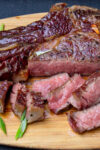
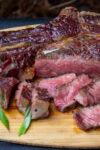
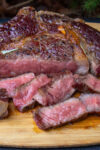
Love this recipe:)